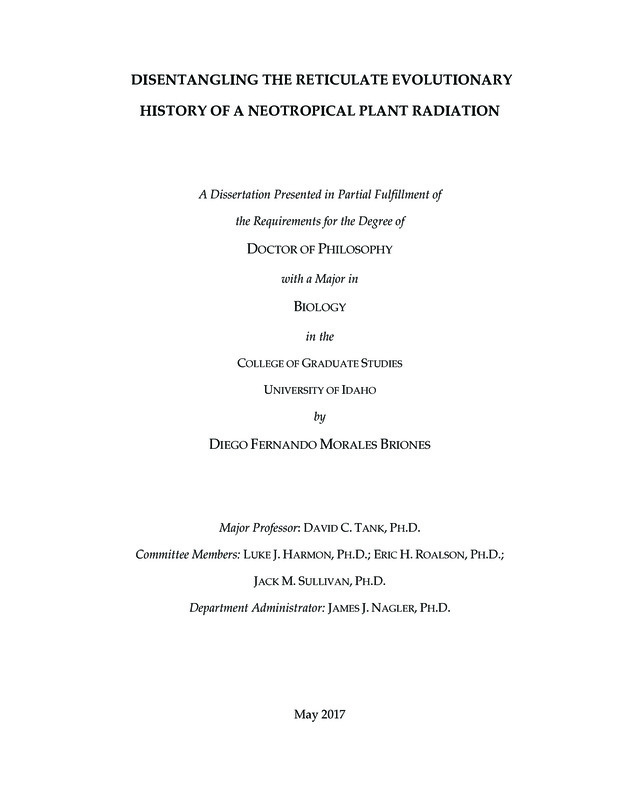DISENTANGLING THE RETICULATE EVOLUTIONARY HISTORY OF A NEOTROPICAL PLANT RADIATION
Morales Briones, Diego Fernando. (2017). DISENTANGLING THE RETICULATE EVOLUTIONARY HISTORY OF A NEOTROPICAL PLANT RADIATION. Theses and Dissertations Collection, University of Idaho Library Digital Collections. https://www.lib.uidaho.edu/digital/etd/items/moralesbriones_idaho_0089e_11108.html
- Title:
- DISENTANGLING THE RETICULATE EVOLUTIONARY HISTORY OF A NEOTROPICAL PLANT RADIATION
- Author:
- Morales Briones, Diego Fernando
- Date:
- 2017
- Keywords:
- Allopolyploidy Hybridization Neotropics Rosaceae Species Networks
- Program:
- Biology
- Subject Category:
- Systematic biology; Botany
- Abstract:
-
Determining the causes and nature of speciation is important for understanding the origin and maintenance of the world’s biodiversity. Hybridization—the exchange of genes between different species—is sometimes recognized as an important process in the evolution of animals and fungi, but seems to be a ubiquitous feature of the evolutionary history of plants where it is particularly prominent. Hybrid speciation can occur either by keeping the same genome size—homoploid hybrid speciation—or more frequently via hybridization and genome duplication—allopolyploidy. Hybridization, in the form of homoploid hybrid speciation and polyploidy has contributed extensively to angiosperm diversity, but also represents a great challenge for phylogenetic reconstruction due the incongruence patterns that a reticulate process produces within and between the nuclear and chloroplast genomes. Additional processes can also produce similar reticulate patterns, creating the necessity to disentangle these processes and model phylogenetic networks that best represent species relationships in the presence of reticulation, rather than a classic bifurcating tree.
This dissertation combines extensive natural history collections with a plurality of molecular phylogenetic methods to elucidate the reticulate evolutionary history of the plant genus Lachemilla in the rose family. This is a morphologically highly variable group of ca. 60 species that includes perennial herbs and shrubs, with a nearly ubiquitous presence in the Neotropical high-altitude grasslands and remarkable diversity in the Andes. First, I reconstructed the phylogeny of Lachemilla using nuclear ribosomal ITS and plastid trnL-F DNA sequences. I identified four major clades in Lachemilla that are in part congruent with previous morphological classifications of the group. However, widespread patterns of cytonuclear discordance was detected that, in combination with chromosome counts and genome size estimates, provided evidence of the putative allopolyploid origin of multiple species. Finally, I established the date of origin of Lachemilla to be around 15 million years ago, with a rapid accumulation of lineages during the last five million years.
In my second chapter, I conducted a phylogenomic analysis of 396 loci from low-copy nuclear genes and complete chloroplast sequences to clarify the relationships among the major groups of Lachemilla, and explore a multiple of sources of conflict among gene trees and species trees. All phylogenetic approaches used recovered the four major groups previously proposed for Lachemilla, but these methods all recovered different topologies for the relationships of these four clades. Species network analyses revealed that one of the four major clades is actually of ancient hybrid origin, and represents one of the main sources of the incongruence among the species trees. Additionally, I found evidence for a whole genome duplication event shared by Lachemilla and allied genera.
In my third chapter, I used PCR target enrichment in combination with high-throughput sequencing to obtain allelic information for the nuclear ribosomal cistron and multiple regions of the plastid genome in 219 samples of 48 species of Lachemilla, to provide direct evidence of the allopolyploid speciation in this group. I found evidence of the allopolyploid origin of 30 species of Lachemilla, demonstrating that this condition is common and widespread in the genus. Additionally, based on a well-resolved chloroplast phylogeny, I identified that the monotypic genus Farinopsis is the sister group of Lachemilla and allied genera within subtribe Fragariinae. However, this result is discordant with the nrDNA phylogeny, a pattern also observed between Lachemilla and allied genera, which corroborates the notion of widespread hybridization in Fragariinae.
Finally, with the extensive fieldwork that I conducted throughout the Neotropics, I discovered and described the new species Lachemilla mexiquense, which is endemic to central Mexico. This species is characterized by a unique combination of characters in the genus, and through the network-based analyses that I conducted, was later shown to be of hybrid origin.
With all this work, I have attempted to clarify the role that hybridization has played in the evolutionary history of Lachemilla. This work will not only facilitate continued research questions, including historical biogeography, diversification patterns, trait evolution, and future taxonomic treatments of the genus, but also broader questions regarding the evolutionary and ecological consequences of polyploidy and hybridization.
- Description:
- doctoral, Ph.D., Biology -- University of Idaho - College of Graduate Studies, 2017
- Major Professor:
- Tank, David C
- Committee:
- Harmon, Luke J; Roalson, Eric H; Sullivan, Jack M
- Defense Date:
- 2017
- Identifier:
- MoralesBriones_idaho_0089E_11108
- Type:
- Text
- Format Original:
- Format:
- application/pdf
- Rights:
- In Copyright - Educational Use Permitted. For more information, please contact University of Idaho Library Special Collections and Archives Department at libspec@uidaho.edu.
- Standardized Rights:
- http://rightsstatements.org/vocab/InC-EDU/1.0/

